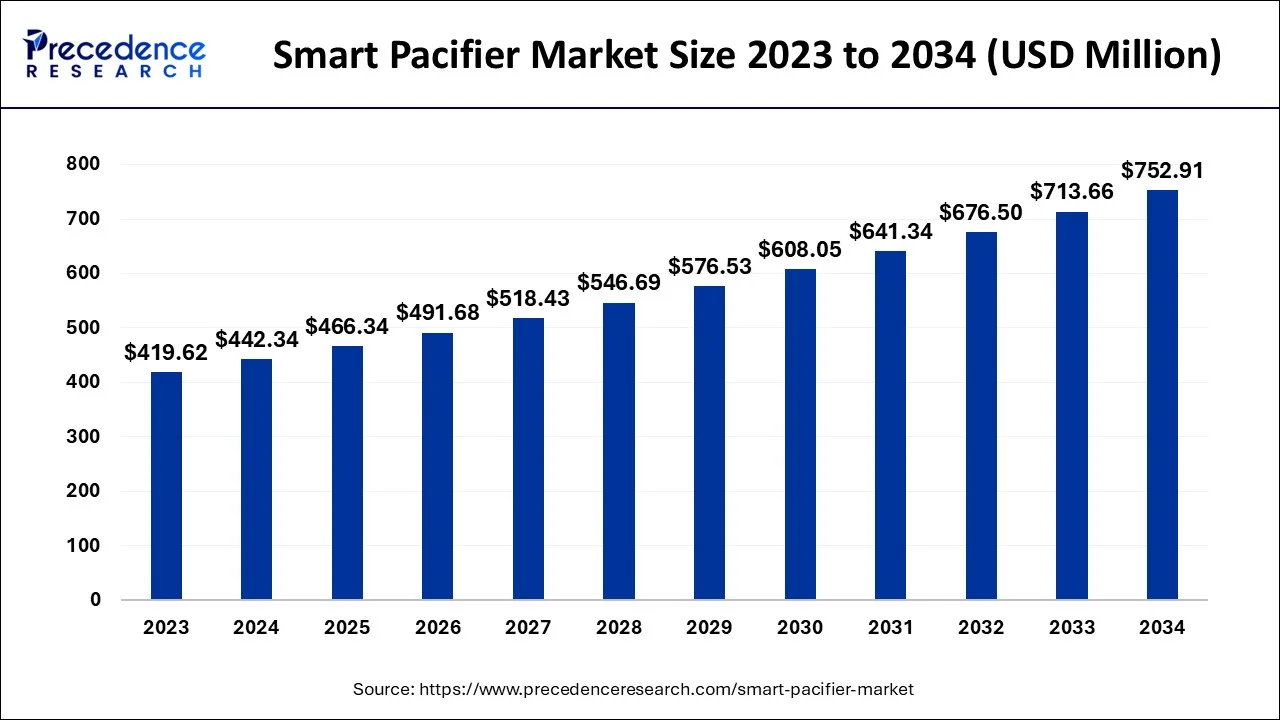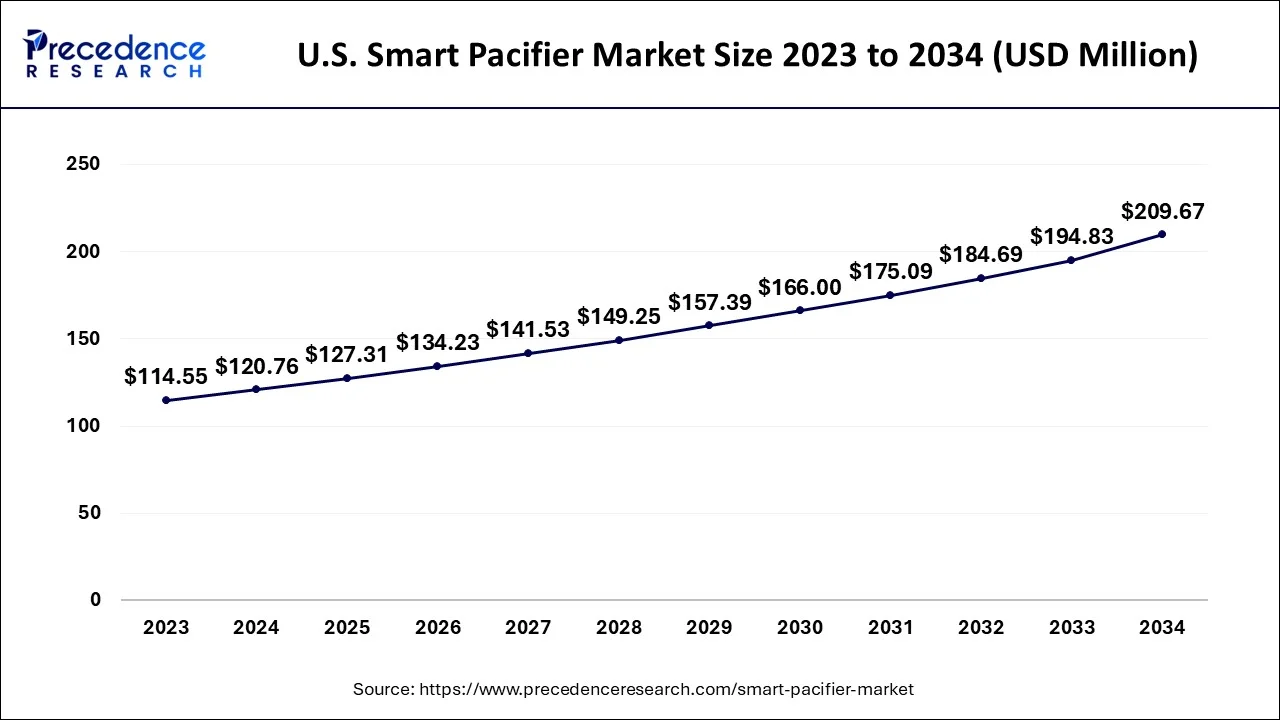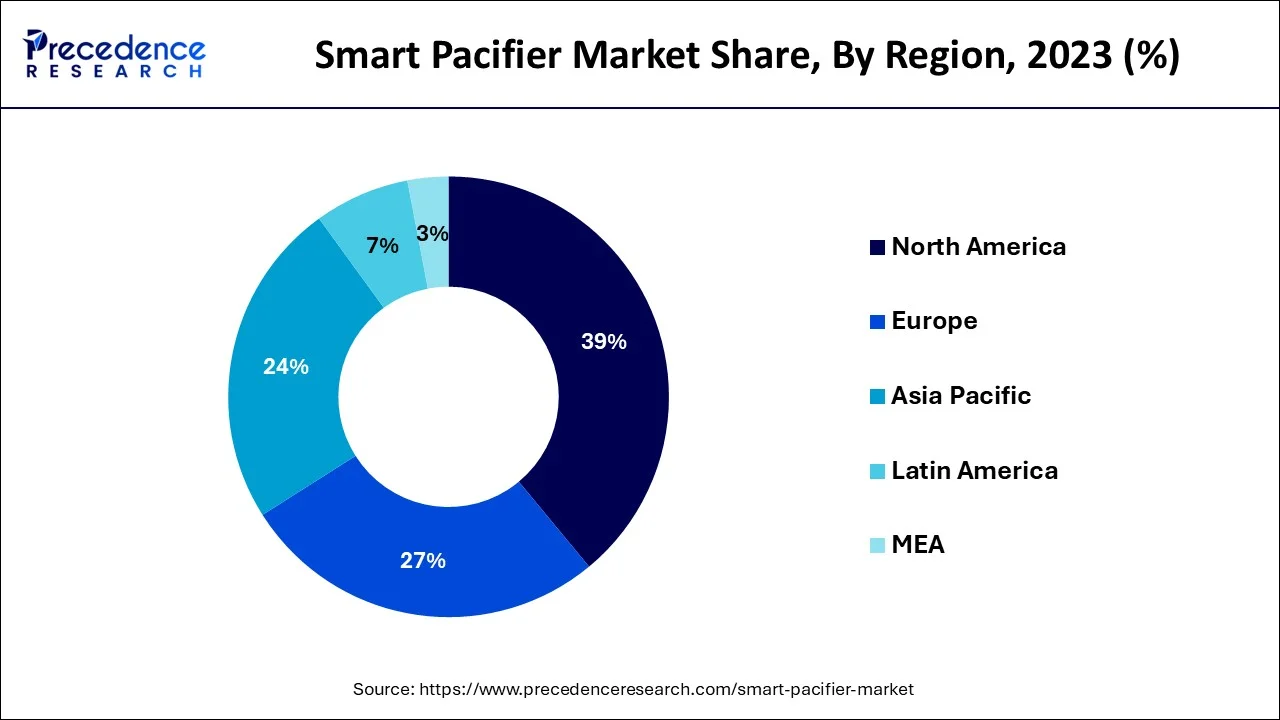May 2024
The global smart pacifier market size accounted for USD 442.34 million in 2024, grew to USD 466.34 million in 2025 and is projected to surpass around USD 752.91 million by 2034, representing a healthy CAGR of 5.46% between 2024 and 2034. The North America smart pacifier market size is calculated at USD 172.51 million in 2024 and is expected to grow at a fastest CAGR of 5.58% during the forecast year.
The global smart pacifier market size is estimated at USD 442.34 million in 2024 and is anticipated to reach around USD 752.91 million by 2034, expanding at a CAGR of 5.46% between 2024 and 2034.

The U.S. smart pacifier market size accounted for USD 120.76 million in 2024 and is expected to be worth around USD 209.67 million by 2034, growing at a CAGR of 5.65% between 2024 and 2034.

Smart pacifiers that help in tracking the electrolyte levels offer premature babies are being used in the North American region. The North American region is expected to have a dominant position when it comes to the usage of these smart pacifiers. This region is expected to have a larger market share in the coming years. In order to increase the use of smart pacifiers in the neonatal intensive care unit there has been an increase in the research to develop a more accessible product. Washington State University is currently working on providing the same. They shall be a growth in the demand for these pacifiers as they will provide a noninvasive way to monitor the health of the baby and they will be extremely useful in increasing the chances of its survival. Followed by the North American region the European region is also expected to have a good market share in the coming years.\

The smart pacifier market is expected to witness remarkable growth in the near future. The smart pacifier is a wireless device which will be extremely beneficial in monitoring the dehydration in the newborn baby and also in monitoring the electrolyte levels. This wireless pacifier will be able to understand the electrolyte levels through the saliva of the newborn baby. This device is expected to be a boon for the caregivers as it will help in better understanding the needs of the baby. The smart pacifier will be able to monitor the potassium levels and the sodium levels without drawing the blood. Apart from sodium and dictation there are other electrolytes like calcium and magnesium which are extremely important for the human body.
Slight changes in them Candace wrapped the body functions to a great extent. By the use of a smart pacifier these electrolytes can be monitored in a non-invasive way. Other type of smart pacifiers were introduced in the market where the ones that provided bluetooth connectivity. These Bluetooth were helpful in monitoring the temperature of the baby. The use of bluetooth for this smart pacifier also enabled location tracking. The smart pacifiers are in their developmental stages when it comes to the neonatal care beard in the coming years it is expected that the advanced version of these smart pacifiers will be introduced in the market.
Excessive use of pacifiers may lead to infections of the middle ear. The other side effect of excessive use of pacifiers is that the pacifiers may affect the oral development in a negative way and it delays the teething process. Prolonged use of pacifiers may misalign tiled speed. The pacifier chosen needs to be larger in size in order to make sure that the child won't choke on the pacifier. A larger base of a pacifier helps in ensuring that the pacifier does not get stuck in the mouth of the infant.
There are many reasons why there's an increase in the use of pacifiers. Pacifiers are extremely useful and comforting the baby. They also aid peaceful sleep in Infants. In the babies below the age of 1 year sudden infant death syndrome is the most common reason for death. The use of pacifier is expected to grow in the coming years as it helps in reducing the chances of sudden infant death syndrome. Increased use of pacifiers is due to its Ability of putting a baby to sleep faster. The bioelectronic pacifiers are non invasive as they help in monitoring the electrolytes in the newborn baby. It also helps in monitoring the cases of dehydration. Smart pacifiers are of great use in the neonatal intensive care units. In case of premature born babies the use of these pacifiers will be extremely useful in order to increase the chances of survival of the infant. There is a growing investment in order to develop better pacifiers that will be recyclable and also affordable.
Smart pacifiers are also useful as they help in monitoring the body temperature. There's a growing demand for the smart pacifiers that use the Bluetooth connectivity which helps in tracking the location and the temperature of the infant or the baby. Previously in order to check the electrolyte balance in the infant’s doctors would draw blood in order to check the levels. The introduction of these smart pacifiers has reduced the use of these invasive ways. Increase in the disposable income and urbanization has led to the growth of the market. As there is a growth in the number of females working, the result growing demand for pacifiers. The market for the pacifiers has also evolved in the recent years by providing innovative pacifiers.
| Report Coverage | Details |
| Market Size in 2024 | USD 442.34 Billion |
| Market Size by 2034 | USD 752.91 Billion |
| Growth Rate from 2024 to 2034 | CAGR of 5.46% |
| Largest Market | North America |
| Fastest Growing Region | Asia Pacific |
| Base Year | 2023 |
| Forecast Data | 2024 to 2034 |
| Market Segmentation | Product, Smart Pacifier, Distribution Channel, Function, Region |
On the basis of the product type the single piece baby pacifier are expected to have the largest market share in the coming years. The baby pacifiers that are available as a single piece are available at lower rates as compared to the multiple piece pacifiers. The use of multiple piece pacifiers also increases the risk of choking in infants. The different types of materials that go in the manufacturing of single piece pacifiers are rubber, silicone or plastic in most of the pacifiers manufactured. As the single piece pacifiers provide better safety as compared to the multiple piece pacifier there is expected to be a larger demand for those pacifiers.
On the basis of the size of the pacifiers, the small sized baby pacifiers market is expected to grow well in the coming years period the small sized baby pacifiers have dominated the market in the recent years period this segment is expected to have the largest growth in terms of revenue. There's a maximum usage of pacifiers in between zero to three months or three to six months of age of an infant. The medium sized pacifier is expected to hold the second position in the global market.
The offline distribution channel, the brick and mortar stores are expected to have a dominant position in the future. The different retail outlets and specialized stores see a maximum sales of baby pacifiers as parents are extremely cautious when buying these pacifiers. The availability of greater variety at the stores is also driving the growth of the market. Major manufacturing companies are also shifting their focus to offering baby pacifiers on the online platform on a larger scale. The online segment is also expected to have a good amount of growth in the coming years. There's a large number of sales through the specialty stores or the medical stores as many smart pacifiers are purchased in order to use in the neonatal intensive care unit.
Currently there are two types of smart pacifiers used in the market depending upon their functionalities. Smart pacifiers that help in monitoring the temperature and tracking the location of a baby is one type and the other smart pacifier is used in the neonatal intensive care units which help in monitoring the electrolyte levels of the baby. The smart pacifier that helps in monitoring the body temperature has grown well in the recent years and it is expected to dominate the market. The use of smart pacifiers that help in monitoring the electrolyte levels in the body has recently been developed and it is expected to grow well in the coming years. The smart pacifier that makes use of saliva in order to monitor the sodium potassium and calcium levels of the infant or a noninvasive technique which shall be in demand during the forecast period. There has been an increasing investment in order to upgrade the current model of these smart pacifiers in order to make them affordable.
Key Market Developments
A bioelectronic and wireless smart pacifier was introduced by Washington State University and they are working on providing cost effective device which will also be more accessible in the future.
Segments covered in the report
By Product Type
By Smart Pacifier
By Distribution Channel
By Function
By Geography
For inquiries regarding discounts, bulk purchases, or customization requests, please contact us at sales@precedenceresearch.com
No cookie-cutter, only authentic analysis – take the 1st step to become a Precedence Research client
May 2024
January 2025
September 2024
January 2025